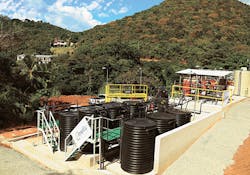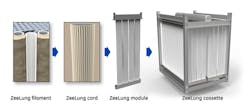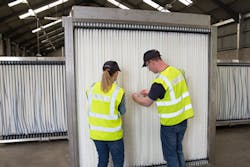A growing number of companies around the world are now actively involved in the development of Membrane Aerated Biofilm Reactor (MABR) technology. The process, which has also been described as ‘bubbleless’ aeration, utilises gas permeable membranes to provide the oxygen required for aerobic biological treatment.
By Andrew Williams
The membrane aerated biofilm reactor (MABR) process is an innovative technology that enables the upgrade of conventional activated sludge plants for nutrient removal and capacity expansion in existing tank volumes, while significantly reducing the energy required for aeration. Generally speaking, the process employs a gas permeable membrane to deliver oxygen to a biofilm that is attached to the surface of the membrane - and has the added bonus of intensifying treatment capacity and improving performance by increasing the biomass inventory in a given reactor volume.
Energy neutrality
One of the early pioneers of the technique is industry behemoth GE, which has developed novel ZeeLung MABR technology, where oxygen is delivered directly to the bacteria without the use of bubbles, resulting in an oxygen transfer efficiency that is four times higher than a fine bubble aeration system.
“MABR is more than an alternative aeration device,” says Jeff Peeters, senior product manager at GE Water & Process Technologies. “It is a process intensification technology that also reduces energy consumption.”
GE has either completed or is currently operating a total of 12 demonstrations of the ZeeLung MABR technology - one of which is a pilot project in partnership with Servizi Ambientali SPA in Borghetto Santo Spirito, a tourist town on the Mediterranean Sea in Italy. Here Peeters says the technology is “demonstrating its potential to achieve energy neutrality”.
“The results have already shown aeration energy savings of four to five times compared to fine bubble aeration and the potential to reduce the biological volume by 50 percent compared to the conventional activated sludge process, while achieving the same effluent limits and up to 80 percent nitrogen removal without the need for internal nitrate recirculation,” he adds.
Although GE invented the ZeeLung gas transfer membrane in its laboratories 15 years ago, Peeters also reveals that the commercialisation of the technology in 2016 was enabled by developing a “robust product that can reliably operate in a wastewater treatment plant environment and a solution for mixing and biofilm thickness control”. He says this was achieved by employing a supported “cord” construction to provide structural integrity and leveraging experience from MBR technology for mixing and scouring.
Looking ahead, Peeters reveals that the first two commercial ZeeLung MABR installations - one at the Yorkville Bristol Sanitary District in the US and another at Schilde in Belgium - are currently under construction and will be commissioned in 2017.
“We see a demand for the technology across the globe with a focus on plants that need to upgrade capacity or effluent quality and wish to do so with an energy efficient solution,” he adds. “We are also partnered with researchers who are exploring new ways to apply the technology to increase the energy savings even further.”
‘Self-Respiring’ Membranes
Another trailblazer in the field is US start-up Fluence, formed following a recent merger between Israeli wastewater treatment company Emefcy and US company RWL Water. According to Ronen Schechter, CTO at Fluence, the company’s MABR technology employs self-respiring membranes to achieve aeration, leading to “much lower energy consumption for wastewater treatment because air does not need to be blown into the depth of the water to provide oxygen for the process”.
“In addition, we design and operate a process that promotes the natural growth of a nitrifying biofilm on these self-respiring membranes, while other processes occur simultaneously in the volume of the water. This means that several process occur simultaneously, that would otherwise require at least two different compartments,” he says.
“Effectively, the MABR module works like the human lung, operating at atmospheric pressure, and is therefore extremely energy efficient. This is in contrast to activated sludge, where air is forced at high pressure through fin bubble diffusers, or MBR, where great force is used to achieve successful treatment,” he adds.
Schechter reveals that Fluence MABR processes are already installed in two full scale plants in Israel and the US Virgin Islands, as well as in several demonstration plants in different parts of China - where he says the longest running plant “has now been in operation for three years without any malfunction and without requiring any maintenance or chemical cleaning”.
According to Schechter, China is currently Fluence’s top priority for rolling out its MABR system, largely because of the country’s five-year plan goal to develop the environmental conditions for rural communities, which he says are “expected to require about 100,000 smaller treatment plants to be built over the next five years”.
“We are also actively selling MABR throughout the Americas - in the US, Caribbean and Latin America - and are also piloting a derivative of MABR called SUBRE, which can be installed in existing aeration tanks at larger plants where improved nitrogen reduction is required,” he adds.
Fixed Film Treatment
Elsewhere, Irish start-up OxyMem has developed another MABR process, based on the results of several years of research into the technology at University College Dublin. As Eoin Syron, technical director and co-founder at OxyMem, explains, the system works by allowing air or oxygen to flow inside a membrane, which is surrounded by the water to be treated - with the resultant bacteria growing in a biofilm on the external surface of the membrane.
Because the air is not pushed directly into the water, Syron says that there is no dissolved oxygen, although the biofilm “is aerobic, and the supplied air does not have to overcome the hydrostatic head even in a deep tank”.
“The flowrate of air through the membrane interior can be reduced, allowing more time to transfer oxygen, resulting in very high oxygen transfer efficiencies of 50-90 percent. The low pressure air combined with high OTE leads to significant energy savings of over 75 percent when compared to traditional aeration technologies,” he says.
In Syron’s view, the key advantage of MABR technology is that it decouples the aeration from a bubble while simultaneously using a fixed film for wastewater treatment. By moving away from a bubble, he points out that the process “removes issues such as foaming, as well as surfactants affecting the alpha factor and clogging or fouling of diffusers”.
“The fixed film treatment process brings the advantages of having longer sludge ages, avoiding washout associated with increased hydraulic load and improved process resilience,” he says. “I think that as engineers and consultants get more familiar and comfortable with the technology and understand how it works they will discover more ways in which the MABR can be utilised to give process advantages in a water or wastewater treatment plant.”
According to Syron, the OxyMem MABR has already been successfully demonstrated in Europe, Africa, Asia and South America on municipal wastewater. It has also proved successful in treating industrial wastewaters from food and beverages, landfill leachate, pharmaceutical and semi-conductor industries - and OxyMem is currently “in discussions in all six populated continents” to install the company’s MABR in wastewater treatment plants throughout 2017 and 2018.
“We will also shortly be carrying out the first drop-in MABR, which will be installed into an operating wastewater treatment plant without taking the process off line,” says Syron.
“This ability to incrementally increase the capacity of an operating wastewater treatment plant, without the need for additional tanks, opens the ability for operators to increase the capacity as required and avoid long planning and construction periods. I think this is a very exciting opportunity especially in countries which have existing wastewater treatment infrastructure,” he adds.
‘Disruptive’ Technology
Ultimately, Peeters believes MABR is disruptive to conventional wastewater treatment because it significantly reduces energy consumption. For him, this is particularly relevant because aeration is the largest energy consumer in a wastewater treatment plant and increasing the efficiency of oxygen transfer by four times is “a game-changer with respect to the energy footprint of a biological treatment process”.
“The MABR process can yield additional energy savings in the plant. For example nitrate recirculation pumping can be eliminated or reduced because the process achieves simultaneous nitrification and denitrification in the MABR reactor,” he says.
“It also intensifies treatment and enables utilities to get more capacity out of existing assets. Conventional wastewater treatment technologies require large footprints. Many utilities that need to expand plant capacity or improve effluent quality do not have the footprint available to build new tankage or face significant capital costs to do so. MABR allows utilities to get more capacity from existing tank assets by increasing the inventory of biomass in the system without increasing mixed liquor concentration,” he adds.
Cost Comparison
Divya Inna, water technology market analyst at BlueTech Research, accepts that the aeration costs associated with MABR technology may be reduced and the biofilm surface area increased. Yet she wonders how the costs of the oxygen-permeable membranes impact overall system costs compared to conventional systems.Based on a BlueTech cost analysis on certain assumptions and backed by information received from a Freedom of Information Act (FOIA) request, she reveals that the company deduced the cost of the membranes does in fact have a significant impact on the overall cost of the total MABR system and “could represent a multiplier factor of over two times the capital costs of conventional systems”.
“This is despite the fact that the higher surface area of an MABR allows for smaller tank and savings in aeration equipment. Now, the savings in energy can of course be used to justify the higher capex based on savings on whole of life costs. So we also took a look at this. It appears that the operational benefit offered by an MABR would not offset the capital costs incurred for a green-field biological treatment system, however the technology may pencil out more favourably if compared to higher cost green-field alternatives such as MBR,” she adds.
Andrew Williams is a freelance contributor for WWi magazine.
More Water & WasteWater International Archives Issue Articles







